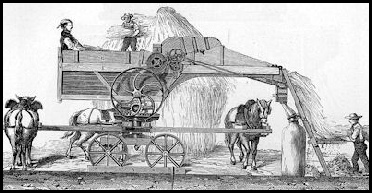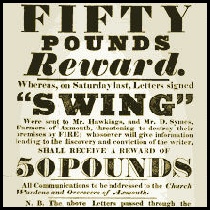Pile Family
Catchlove Family
Scott Family
Westbourne Family
References
Kelly's Directory 1911
Listed Buildings
The River Ems

WESTBOURNE
A village history in West Sussex
YESTERYEAR
Home | Personal | Church | Scouts | Schools | Ambrose | Sketchbook | Workhouse | Census | Memories | Yesteryear | Publications | Village Website
For generations Westbourne had been an agricultural community with the majority of the local people, particularly the unskilled ones, working on the land as agricultural labourers, they were employed, in the main by small tenant farmers who in turn farmed the land of larger landowners and large local estates. Since the late eighteenth century the agricultural economy in southern England had become increasingly mechanised, the introduction of threshing machines into arable communities caused considerable distress amongst the labouring people as it threatened their employment and already low wages of around 1s 8d per day.
Since 1808 there had been a number of uprisings in various parts of the country particularly in rural areas but also in the increasingly machinery dominated factories, most famously the Luddite riots of 1811 in the Nottinghamshire lace industry.
 The introduction of this machinery, low wages and a series of bad harvests in the late 1820’s had finally pushed the agrarian population to rebel and the situation came to a head in the village of Lower Hadres near Canterbury in Kent on 28 August 1830 when a threshing machine was destroyed. These riots came to be known as the Captain Swing Riots because of a number of letters and notices sent about which were signed Captain Swing or just Swing. The identity of the person or persons responsible for these letters was never established. Over the next few months cases of machine breaking spread throughout south and east England together with rioting, arson, larceny, threatening letters and many meetings and seditious gatherings. A great deal of damage was done in the neighbourhood of Westbourne; a party afterwards went to Emsworth, and destroyed a machine, the property of G. Holloway, Esq. ... At Westbourne and neighbourhood, where the rioters are said to exceed 500 a large party of yeomanry and special constables are gone with the magistrates.
The introduction of this machinery, low wages and a series of bad harvests in the late 1820’s had finally pushed the agrarian population to rebel and the situation came to a head in the village of Lower Hadres near Canterbury in Kent on 28 August 1830 when a threshing machine was destroyed. These riots came to be known as the Captain Swing Riots because of a number of letters and notices sent about which were signed Captain Swing or just Swing. The identity of the person or persons responsible for these letters was never established. Over the next few months cases of machine breaking spread throughout south and east England together with rioting, arson, larceny, threatening letters and many meetings and seditious gatherings. A great deal of damage was done in the neighbourhood of Westbourne; a party afterwards went to Emsworth, and destroyed a machine, the property of G. Holloway, Esq. ... At Westbourne and neighbourhood, where the rioters are said to exceed 500 a large party of yeomanry and special constables are gone with the magistrates.
On 3 November the riots spread into Sussex, the authorities believed that the people had been “excited by a lecture lately given here publicly by a person named Cobbett.” This was William Cobbett, a well known political agitator and writer.
On Wednesday 17 November threshing machines were destroyed at Emsworth, Funtington and Westbourne and the following evening more damage was done at Westbourne; The Times of 23 November 1830 reported,
The labourers went about in larger numbers, combining with the destruction of threshing machines and the demand for higher wages a claim for 'satisfaction' as they called it in the form of ready money. It was their practice to charge £2 for breaking a threshing machine, but in some cases the mobs were satisfied with a few coppers.
In his book, Bourne in the Past, Dr Mee relates a story told to him by Henry Terry who witnessed the events (although he was not sure whether the events took place at Westbourne or Warblington). He tells of William Woods, one of the ringleaders, mounting the machine in the Square and inciting the crowd to destroy it, which took only ten minutes. Mee also refers to the names Hudson, Reed and Smith.
 The following morning there were further disturbances at Havant and later that day nine threshing machines were broken there and beer and money were demanded of local people. On Thursday evening the Portsmouth Garrison was mobilised. The authorities had learned that the rioters had a “committee” at Westbourne at which many of the riots in West Sussex and over the Hampshire border were organised and two Sussex magistrates went to Westbourne with about 30 armed and mounted men.
The following morning there were further disturbances at Havant and later that day nine threshing machines were broken there and beer and money were demanded of local people. On Thursday evening the Portsmouth Garrison was mobilised. The authorities had learned that the rioters had a “committee” at Westbourne at which many of the riots in West Sussex and over the Hampshire border were organised and two Sussex magistrates went to Westbourne with about 30 armed and mounted men.
The Emsworth rioting party had in the meantime returned to Westbourne where they apparently made no attempt to conceal their criminal activities and subsequently nine of the most active were promptly arrested, one of those taken into custody was George Pile. A report in The Times had suggested that the mob was as much a five hundred strong.
Four of the arrested men were taken to Petworth gaol, the other five were taken to Havant for “examination” before the magistrates that evening, two of these were committed for trial at the assizes the other three were remanded to have further examination the following week.
Geo Pyle’s family being left destitute in consequence of his being taken into custody, the overseers were desired to relieve her as the occasion requires.
On Tuesday 21 December 1830, George Piles, Hurlock Crockford, Thomas Reed, James Newland and John Freeland all labourers in Westbourne appeared before Mr Justice Bosanquet at Sussex Assizes in Lewes on three counts of “unlawfully, maliciously and feloniously” damaging a threshing machine, the property of Mary Harfield valued at forty pounds. Crockford, Freeland and Reed were sentenced to transportation “across the seas” for seven years; George Piles and James Newland were found not guilty by the jury and acquitted. Crockford and Reed were in fact transported to Van Dieman’s Land (now Tasmania) on the ship Eliza II that sailed from Portsmouth on 6 February 1831 and arrived in Van Dieman’s Land on 29 May 1831.
In total 52 Sussex men were tried in four courts, 18 were acquitted, 16 imprisoned and 17 transported to Van Diemans Land, the remaining three were sentenced to death one of whom was hanged (for arson) at Horsham.
One can hardly imagine the effect that the arrests would have on the men’s families with the loss of the main breadwinner and no social security to fall back on. Back in Westbourne the Select Vestry awarded relief to the families of those imprisoned and apparently placed them in the poor house.
On 26 November 1830 the Select Vestry Minutes record that Martha Pile amongst others was eligible for relief. The minutes also record the names George Welsh, Stephen Smith, James Newland, William Wood, Thomas Reed and William Ginman as having received relief. The families of Hurlock Crockford and John Freeland who were tried with George are not mentioned.
The Westbourne Select Vestry also records that several parishioners had been transported even referring to their wives as widows!
Thomas Reed suffered one final indignity following his transportation when in March 1833 his wife gave birth to a child, the parish register does not name a father but does refer to the child being born two and a quarter years after Thomas Reed had been transported for seven years!
PS. Captain Swing didn't exist. He was an entirely mythical figure whose name was sometimes used to sign the threatening letters that labourers sent to farmers.